Day 1 in Tanzania
I woke to a misty morning filled with the sounds of birds. I pulled back the mosquito netting that wrapped around the sleeping area and opened to drapes to a spectacular garden panorama.
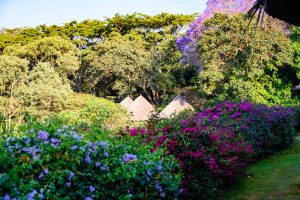
The morning view from my hut looks out on lush gardens and other huts nestled into the jungle.
Jacaranda, flowering shrubs and numerous trees flourish on the landscape. In the distance, Lake Duluti shimmers.
Each hut has a spectacular view and mine is breathtaking. I shrug off the fatigue of travel and consider breakfast up at the lodge.
The Serena Lodge in Arusha is a collection of beautifully appointed huts, nestled on acres of manicured grounds. The property has a vaguely British feel to it, with dark woods and white starched tablecloths in the dining room, and floral prints in the bar.
Breakfast is a daily buffet that includes fresh mango, passion and other juices; eggs prepared to your liking; breads and sweets; fresh fruit; cheese and meat; baked sweet potatoes and more.
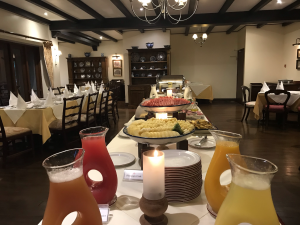
The breakfast buffet
And freshly dripped African coffee.

Rich, lush African coffee on the grassy patio
This is coffee as it should be. Each sip is rich with the essence of roasted beans. There is a body to the beverage–not a thickness but a sense of aromatic presence that translates into an almost savory, lingering flavor.
It is simply delicious. I could become a coffee drinker again.
Africa is a different place. It is simultaneously exotic, ordinary, lush, and lean. I was currently experiencing lush, although just a few miles outside the gated property, was lean.
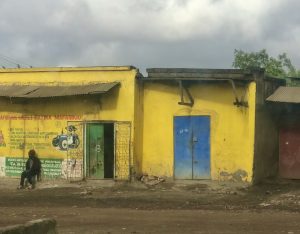
Local life is often very rudimentary
This disconnect, from the tourist experience to the local reality is one that I will witness throughout our trip. But people everywhere seem kind and helpful. The pace is relaxed.
Back at the hotel, echoes of British monarchy seemed to linger, in the language, in the food, and in the interior architecture of the Serena.
Which got me to wondering about the history of Tanzania.
A Short History of Tanzania: The Portuguese, The Germans and the British
The region that would become Tanzania was known as Tanganyika throughout its colonial history. It would not be until April 26 of 1964 that Tanganyika and Zanzibar would be united and the name Tanzania (a blend of Tanganyika an Zanzibar) became official.
Early western influence dates back to Vasco da Gama’s 1498 visit to the region. In 1505 the Portuguese capture of Zanzibar established trade.
In the early 18th century the Portuguese ceded control to Omani Sultan Seyyid Said who, with the assistance of the Omani Arabs, conquered Zanzibar in 1840 and made it the capital of the slave trade.

Originally discovered by the Portuguese, Tanzania would also interest the German and British.
German exploration in the mid nineteen century led to the discovery of Kilimanjaro by Johannes Rebman and brought railroad transportation and roads to the area. In 1885 the German East Africa Company took over the region, bringing railroads and roads.
The German defeat in World War I and the terms of the Treaty of Versailles then ceded the territory to the British.
World War II brought more western influence to the region. One hundred thousand natives fought for the Allied forces in Somaia, Abyssinia, Madagascar and in Burma. Food became an important export for Tanganyika during this period.
After the war, Tanganyika became a U.N. Trust Territory. But the gradual transition to independence was begun. The colonial officer David Gordon Hines was instrumental in helping to develop farming cooperatives that encouraged trade.
And in December of 1961 Tanganyika became independent from the British and all European rule.
Hiking Lake Duluti
Lake Duluti is a lake in Tengeru, on the eastern edge of the eastern branch of the Great Rift Valley. It was most likely formed when a volcano collapsed, leaving behind a small caldera that filled with water.
The lake lies just beyond the gates of the Arusha Serena. A hike seemed the perfect anecdote to over 30 hours of transcontinental travel.
A guide is required, as is signing in at the entry. Beyond that, the jungle envelopes you. You are now in its element and any notions of separation vanish. Animals move about; monkeys jump through the trees. Beautiful purple Jacaranda trees are interspersed along the lakeshore.
And in the distance, 14,980 foot tall Meru rises, overlooking it all.
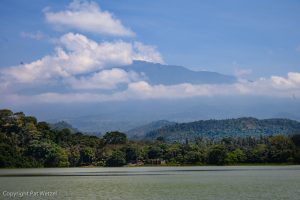
Meru looms over Lake Duluti
Meru isn’t as tall as nearby Kilimanjaro (19,341) but it is a more difficult and technical climb. While Kilimanjaro can be summited by most people in very good shape, Meru presents about 4,000 feet of technical climbing plus a 1,500 foot climb over nearly featureless granite.
But climbing is not on my agenda. A simple walk around Lake Duluti is.
Views from Lake Duluti

A view across Lake Duluti with purple flowering Jacaranda trees on the far shore

Canoe a trois
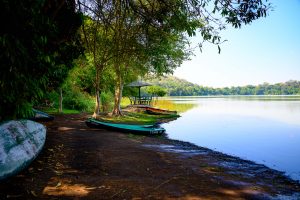
Looking down Lake Duluti

A bird resting lakeside
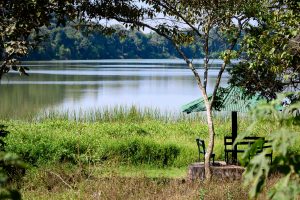
A seating area at the lake
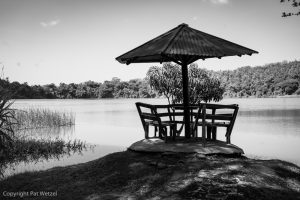
Picnic at Duluti anyone?
The hike around Lake Duluti is an easy one. After a day and a half of travel, this was exactly what I needed to start settling into Africa.
That and a glass of wine. As the evening approached, I approached the beautiful wood bar nestled in the corner of a room set with groupings of sofas and chairs, some in a floral print reminiscent of English chintz.
“Wine?” I inquired.
A nod and a smile from the bartender.
“What kind?” I asked, not sure how detailed to make my inquiry. Savignon Blanc, Chenin Blanc, Chardonnay?
“South African,” the bartender responded.
But of course.
And a well bodied and balanced Chenin blanc accompanied me out to the grassy patio overlooking the property.
As the sun sets, the air cools and the cicadas chirp. A Chinese group gather around one table, playing a ukulele. An Australian couple sits without speaking.
The wind moves. Every tree has its own dance. And with my first day in Africa, I start to settle in at 4,300 feet in the lush jungle.
More Reading On My African Safari
An African Photo Safari With A Nikon Ambassador
Safari Clothes: Packing for Safari
An African Photo Safari: Photo Equipment Packing List
Visas and Vaccinations for Tanzania
Like This Post? Pin It!
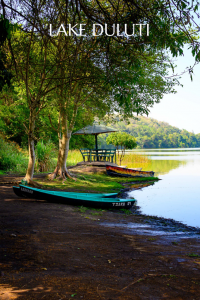
If you’re interested in learning more about photography (or cooking or film or any number of topics) check out MasterClass All-Access Pass for on-line excellence:
 [et_bloom_inline optin_id=”optin_10″]
[et_bloom_inline optin_id=”optin_10″]
What is #CancerRoadTrip and how did it come to be? Read this post to get the backstory!
Follow me on Twitter, Pinterest, Instagram, and at Anti-Cancer Club. Connect with me! I may need a place or two to stay along the way!

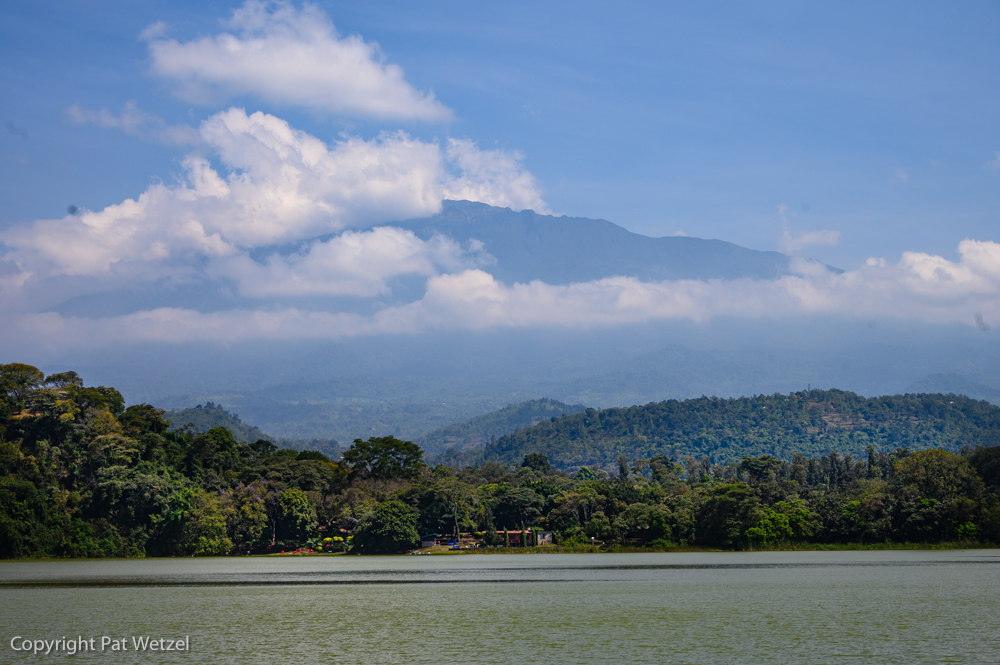







Oh Pat I have missed your blog! SOmehow it was not longer coming to my Email but YEA you are back. Glad to see your smiling face!
Bobbi Gillis
Moved from Reno to Denver 9 mos ago – Come visit!
Hi Bobbi!
We had some technical issues that are now resolved. Everything is moving ahead for the start of the documentary film series for 2020 (yay!). Here’s an overview. We have to connect one day!
Be well, talk soon.
Hello from Staffordshire in the Uk. On days when the fatigue is so bad that I can’t even think, reading your blog gives me a chance to feel I’ve moved off the sofa… if only in my mind! Thank you. Wishing you safe onward travels.
Thank you! Part of me is driven to do as much as possible because no one knows what the future holds. And the idea of CancerRoadTrip, of giving healing retreats to others, just drives me. Cancer can be so difficult. I am so grateful if this brings some joy into someone’s life. Sending you good energy.
Pat, so much time has gone by, but I’m glad to see your adventures continue. The photos are just gorgeous! Have a wonderful time. I know you will.
We’ll have to connect one day! I’ll email. In the meantime, glad you’re enjoying the photos. Many more to come!
Great capture of your first day in Tanzania. We had similar experiences when we visited in September. The disparity between the luxury of our lodges and the locals‘ homes was difficult to accept. But we know how important tourism is to this country.
It is. And absolutely everyone we met was great. At one point we had some trouble with our vehicle and an entire Maasai village came out to help us. And the people at one of the lodges sang one night. Yes, it was for the tourists, but it was so inspiring and beautiful! In many ways, it’s one of my favorite memories.